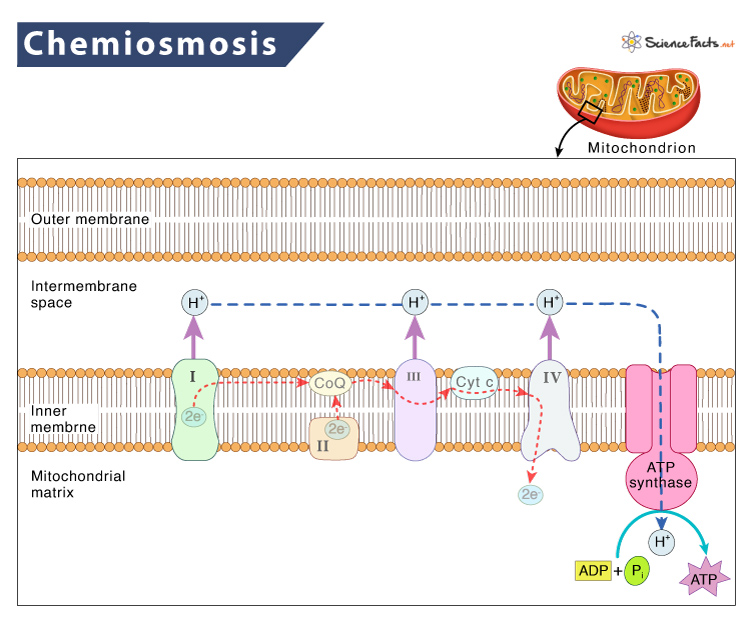It is the final part of oxidative phosphorylation. The initial part is the electron transport chain.
Where Does Chemiosmosis Occur
Function of Chemiosmosis
Chemiosmotic Theory
How does Chemiosmosis Produce ATP in Cellular Respiration
Chemiosmosis in Chloroplasts
Chemiosmosis in Prokaryotes
However, chemiosmosis requires a membrane to allow the electrochemical gradient to develop. The pyruvate is further metabolized to acetyl CoA and then to citric acid or citrate through a series of steps in the citric acid cycle in the mitochondrial matrix. This cycle, with reducing intermediates like NAD and FAD, form NADH and FADH2. These intermediates act as electron carriers in the electron transport chain. When the electrons move down the electron transport chain, protons are pumped across the mitochondria’s inner membrane, creating an electrochemical gradient, which eventually phosphorylates ADP to ATP. This final step is called chemiosmosis.
Steps of Chemiosmosis
The steps below describe how chemiosmosis occurs in the mitochondria of eukaryotes: Complex I -> Complex II -> Coenzyme Q -> Complex III -> Cytochrome c -> complex IV -> Oxygen
The hydrogen ions or protons are in lower concentration inside the mitochondrial matrix. The energy liberated by electrons helps to pump protons into the intermembranous space against their concentration gradient. The energy of electrons is stored as an electrochemical gradientWith the increase in the concentration of protons in the intermembranous space, they move down their concentration gradient along the proton channel in the ATP synthase. This process is coupled to turn the proton ring and liberate energyThe enzyme ATP synthase uses this energy to phosphorylate ADP, forming ATP on the stroma
How Many ATP Does Chemiosmosis Produce
At the end of aerobic respiration, around 32 ATPs are produced from one glucose molecule. Among these, 2 ATPs are from glycolysis, 4 from the Krebs cycle, and the remaining 28 from chemiosmosis.
Inhibition of Chemiosmosis
Chemiosmosis is inhibited by inhibitors of the electron transport chain or uncouplers. They are protein channels that provide an alternative path for entering the stroma without the involvement of ATP synthase. The energy of the electrochemical gradient gets wasted as heat. 2, 4-dinitrophenol, desaspidin, and dicoumarol are typical examples of uncouplers. The drug aspirin is also an uncoupling agent.
In Non-cyclic Electron Flow
Here, the photoexcited electrons pass through the ETC but do not return to photosystem I. As photoexcited electrons from the photosystem I move through the electron transport chain, energy is liberated that pumps protons from the stroma of chloroplasts into the lumen of thylakoids. The flow of electrons is: Photosystem I -> Plastoquinone -> Cytochrome Complex -> Plastocyanin -> Photosystem II -> Ferredoxin -> NADP The protons move down the concentration gradient back into the stroma, passing through the proton channel of ATP synthase, rotating the ring, and liberating energy, which is used to generate ATP from ADP
In Cyclic Electron Flow
At the end of each cycle, the photoexcited electrons pass through the ETC and return to photosystem I. The flow of electrons is: Photosystem II -> Ferredoxin -> Cytochrome Complex -> Plastocyanin -> Photosystem II The mechanism of ATP production is the same as the non-cyclic flow of electrons.
